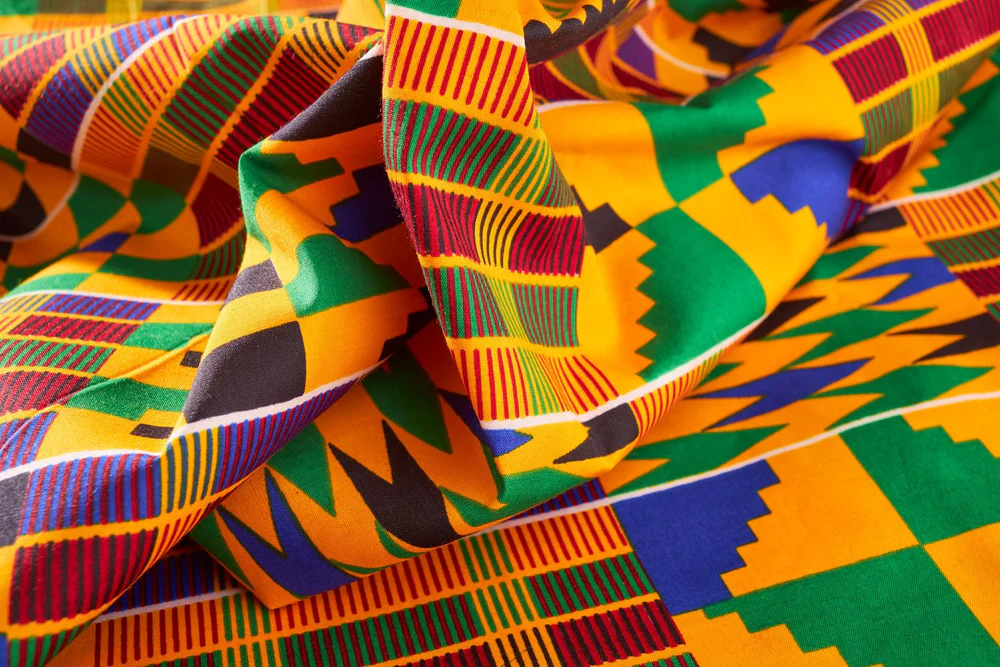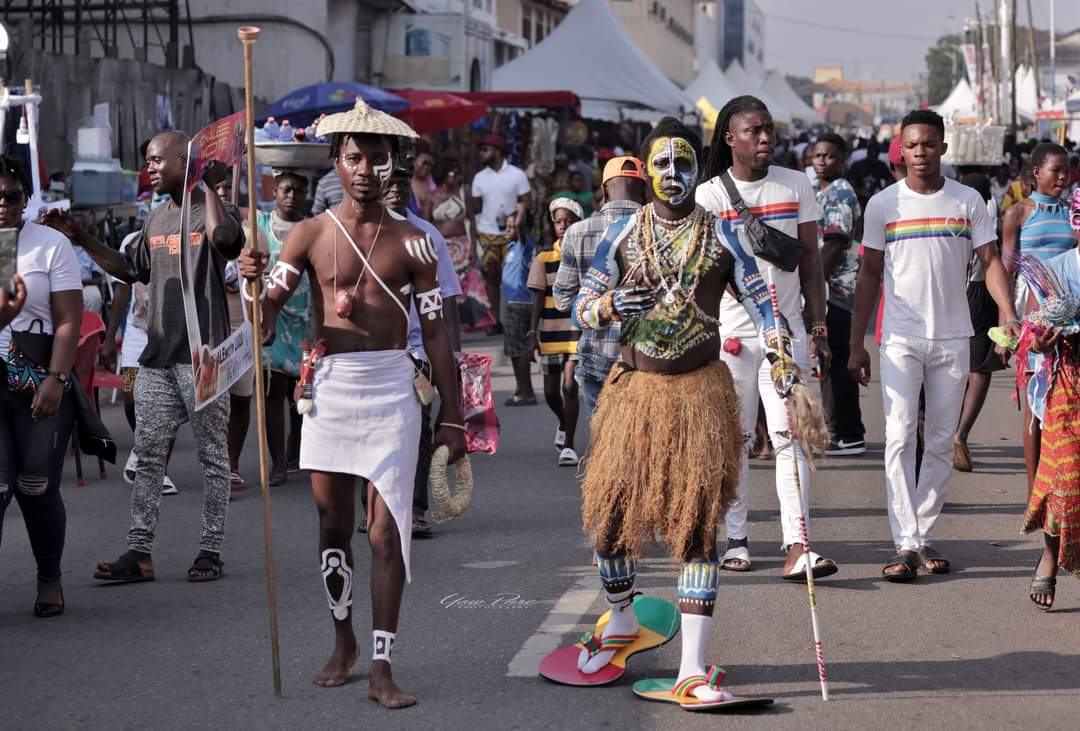[Featured Snippet FAQ] What is Kente?
Kente is a popular traditional Ghanaian cloth made using a wooden loom. It is popularly woven by the Asantes and Ewes. However, it’s also made on smaller scales in Togo. It isn’t the only cloth made with looms but it is the most popular. Kente comes in very bright colors which are often used to encode messages such as proverbs, wise sayings, names, and other symbolism. The cloth is often made of silk, rayon, and cotton. The use of Kente is traditionally for occasions such as festivals, funerals, ceremonies, and rituals. The traditional use has been transferred down the many centuries which the cloth has existed. Today, Ghanaians, Africans, and the world at large enjoy the cloth loosely without the traditional use case. However, it is still largely preserved for important occasions such as graduation ceremonies, weddings and engagements, and other important life events. Popular uses of the cloth include the Kente scarf worn by Chadwick Boseman in the Black Panther movie produced by Marvel Studios. It’s common that the cloth is used as a family heirloom passed down from generation to generation. Kente started to garner national and international attention when Kwame Nkrumah, Ghana’s first President wore the “Mmeeda” translated as “Something that has not happened before”. This happened on February 12, 1951, when the would-be President of the Republic of Ghana was released from prison under British rule. Commentators indicate that the use of kente was a symbol or better still an omen for what was to come, “Something that has not happened before”.Special, Most Expensive African Kente Designs Ever!
There are over 50 kente designs. Each kente design is made with specific patterns, colors, and meaning. Kente symbolizes a lot of things and is in high demand. These form some of the reasons why African kente is expensive.
Origins and History of African Kente Cloth
The Ghanaian and African society has largely been built on folklore, oral traditions, and vibrant culture of storytelling. The origins and history of kente come in the form of a story, folklore. In the 17th century, legend has it that Ananse, the wise and cunning spider taught two hunters how to weave intricate designs like his web when he encountered them. He offered to teach them if they granted him some favors in return which they gladly did. The hunters, Kuragu and Ameyaw, returned to the village perfecting and propagating their discovery. They called the cloth “Nwin-Ntom” which translates as “woven-cloth” in English. The two later showed their invention to the chief of Bonwire titled the Bonwirehene, Nana Bobie Ansah I. Nana Bobie Ansah reigned as ruler of Bonwire from 1610 to 1727. With excitement, the chief took them to show their creativity to the Asante King titled Asantehene, Otumfuo Opemso Osei Tutu I (1695-1717). Impressed with the beautiful cloth, the Asantehene made it the official royal clothing. He didn’t only adopt it for his royal court, he also named it ”Gagamuga”. The hunters continued to refine their work and came up with a new design which was subsequently called “Kenten-Nwin-Ntoma” which means “woven-basket-cloth” later corrupted as only “Kente”. The name was used as a kind of description of the design since it looked like a woven basket. These two events make the ground for a tradition which followed till date: the naming of kente cloths. This doesn’t end the story of kente. The cloth is woven broadly by Asantes and Ewes. And there is a Ewe side of the story. The Ewe people the Asantes have a history of friendship and alliance. Ewes would have it that the Asantes learned to weave from them. And there’s also an etymology in the Ewe language. In Ewe, “Ke na te” means “To open and to press” describing the process used in the weaving of the cloth. Ewe literature reports that the term was also corrupted to “Kente”. To date, there isnt a single story or an agreement on the origin of the cloth. An alternate to the Asante story is reported by Kitenge; The first Otumfuo sent people to Togo to learn the weaving of kente.The Making of Kente
Despite the two-story history of the cloth, the weaving process is almost the same for both Ewes and Asantes. The method is called strip weaving. In strip weaving, the loom is the main tool used to make the setup. The cloth is woven in strips using thread put in a bobbin inserted into a shuttle. The thread is also spread a long stretch from the loom. The stretch consists of two threads called warp horizontally and vertically. There is also a vertical intersection to weave the cloth which is inserted in the bobbin and run through the warps to create the woven strip. These strips are then sewn together to create the desired cloth. The weaving is mostly done by men even though the trend is changing. Even industrial kente is being made by textile companies as print materials instead of woven since it’s extremely difficult to replicate the handwoven process at an industrial scale.Types of Kente Cloth
Kente is widely made by Asantes and Ewes in Ghana and parts of Togo. In a broad sense, where the piece of cloth determines its type. Even these ethnic groups are popular for making the cloth, there are specific towns known for weaving. On the Asante side, Bonwire is the most popular town known for weaving the cloth. Others include Sakora Wonoo, Ntonso, Safo, and Adanwomase. Two Ewe towns stand out when it comes to weaving: Kpetoe and Agbozume. The cloth has a lot of symbolism and meaning some of which include names of chiefs, proverbs, and wise sayings. Specific designs are given names. Anywhere the design is replicated, the cloth bears the original name. Hence this is an alternative system for putting them into types based on names and design patterns.Beautiful African Kente Designs For Engagement 2021
In Ghanaian society, wherever people are gathered for traditional engagement, there is kente. These are the best kente designs for engagement in 2021. ,
[List] Some traditional kente design names include
- “Adwinsa” – Literally means “all motifs are used up”
- “Sika Futoro” – Meaning “gold dust”
- “Abusua Ye Dom” – meaning “the extended family is a force.”
- “Emaa Da” or “Mmeeda” – meaning “it has not happened before” or “it has no precedence.”
Kente in the African Diaspora, African-American Communities, and World Politics
Kente is more than a fashion statement and expression. It isn’t just an ethnic cloth. Every year, thousands of young people wear kente regalia for graduation. The single most popular item is the stole. Others include scarfs and clothing. For most of these young high school and university graduates, it goes beyond fashion. Wearing the cloth is a way for them to reconnect with who they are, their heritage, and something they can be proud of. In politics, the cloth has made a lot of waves. In 2020, only last year, American democrats made political statements in solidarity with George Floyd who died as a result of police brutality. They did this while proposing amendments to legislation. Decades ago, Bill Clinton and His Wife wore kente during their visit to the capital of Ghana, Accra. The cloth has become probably the most influential and best known African piece of culture, fashion, and clothing.What Do The Colors In The Kente Cloth Mean?
Colors are very significant in most African cultures including the use of colors in weaving the cloth. These colors have their meanings whenever they are used. In a traditional sense, the colors bear the same meaning based on the message the weaver or designer wants to convey.[List] From Wikipedia, these are the various meanings of color:
- Black: maturation, intensified spiritual energy, spirits of ancestors, passing rites, mourning, and funerals
- Blue: peacefulness, harmony, and love
- Green: vegetation, planting, harvesting, growth, spiritual renewal
- Gold: royalty, wealth, high status, glory, spiritual purity
- Grey: healing and cleansing rituals; associated with ash
- Maroon: the color of mother earth; associated with healing
- Pink: assoc. with the female essence of life; a mild, gentle aspect of red
- Purple: assoc. with feminine aspects of life; usually worn by women
- Red: political and spiritual moods; bloodshed; sacrificial rites and death.
- Silver: serenity, purity, joy; associated with the moon
- White: purification, sanctification rites, and festive occasions
- Yellow: preciousness, royalty, wealth, fertility, beauty
Symbolism in Kente Cloths
One of the critical differences between Asante (Bonwire) and Ewe kente is the patterns. Traditionally, Ewe cloths bear more representational meaning in design while Asante designs are more abstract. It is common to see woven images of people, text, and other representations in Ewe cloths. Asante cloths are more recognizable in name before meaning comes in since they are abstract. However, trends have changed. Ewes now weave designs Asantes would traditionally weave. This is largely attributed to the market demands for “Modern” designs. Also, brighter colors are used in the present day than before. Like other African print cloths, Kente cloths have names. These range from names of people who commissioned the design, names of chiefs, proverbs, wise sayings, and so forth. One of such popular symbols in its right is the Adinkra symbols. Each symbol has its meaning. The symbol can be woven into cloth to bear the meaning of the design. The colors are instructional as to the kind of events one should wear the cloth for.Conclusion
The history of Kente may have started as the creation of two hunters in a remote part of the world. Centuries later, the story of the legendary is not only told again, but the cloth is also making lots of impact in politics, fashion, society through its symbolism, meaning, and attractiveness. If this isn’t the purpose of culture, uniting people, connecting Africans everywhere in the world, then what is? Kente is a true treasure and everyone should know its story, origin and learn a thing or two from its symbolism.Discover more from Ghana Scoop
Subscribe to get the latest posts sent to your email.





